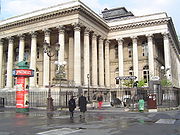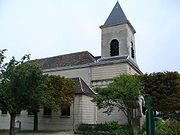
Alexandre-Théodore Brongniart
Encyclopedia

France
The French Republic , The French Republic , The French Republic , (commonly known as France , is a unitary semi-presidential republic in Western Europe with several overseas territories and islands located on other continents and in the Indian, Pacific, and Atlantic oceans. Metropolitan France...
architect.
Born in Paris, France. A prominent member of Parisian society, in 1767 he married Anne-Louise d'Egremont. The couple became friends of the royal portrait painter, Marie Louise Élisabeth Vigée-Lebrun who painted the portrait of their daughter, Alexandrine-Emilie Brongniart that now hangs in the National Gallery
National Gallery, London
The National Gallery is an art museum on Trafalgar Square, London, United Kingdom. Founded in 1824, it houses a collection of over 2,300 paintings dating from the mid-13th century to 1900. The gallery is an exempt charity, and a non-departmental public body of the Department for Culture, Media...
in London
London
London is the capital city of :England and the :United Kingdom, the largest metropolitan area in the United Kingdom, and the largest urban zone in the European Union by most measures. Located on the River Thames, London has been a major settlement for two millennia, its history going back to its...
, Mademoiselle Brongniart 1788. During the Reign of Terror
Reign of Terror
The Reign of Terror , also known simply as The Terror , was a period of violence that occurred after the onset of the French Revolution, incited by conflict between rival political factions, the Girondins and the Jacobins, and marked by mass executions of "enemies of...
, Vigée-Lebrun hid in Brongniart’s home before fleeing the country.

Alexandre Brongniart
Alexandre Brongniart was a French chemist, mineralogist, and zoologist, who collaborated with Georges Cuvier on a study of the geology of the region around Paris...
that are now in the Louvre Museum
Louvre
The Musée du Louvre – in English, the Louvre Museum or simply the Louvre – is one of the world's largest museums, the most visited art museum in the world and a historic monument. A central landmark of Paris, it is located on the Right Bank of the Seine in the 1st arrondissement...
in Paris. Brongniart Jr. went on to become a respected geologist and director of the famous Sèvres porcelain manufactory. In turn, his son Adolphe Theodore Brongniart
Adolphe Theodore Brongniart
Adolphe-Théodore Brongniart was a French botanist. He was the son of the geologist Alexandre Brongniart and grandson of the architect, Alexandre-Théodore Brongniart. Brongniart's pioneering work on the relationships between extinct and existing plants has earned him the title of father of...
became a famous botanist known as the father of paleobotany
Paleobotany
Paleobotany, also spelled as palaeobotany , is the branch of paleontology or paleobiology dealing with the recovery and identification of plant remains from geological contexts, and their use for the biological reconstruction of past environments , and both the evolutionary history of plants, with a...
and a recipient of the Wollaston Medal
Wollaston Medal
The Wollaston Medal is a scientific award for geology, the highest award granted by the Geological Society of London.The medal is named after William Hyde Wollaston, and was first awarded in 1831...
in science.
Alexandre-Théodore Brongniart designed hotels, including the Hôtel de Bourbon-Condé and the Hotel de Monaco, and a number of exclusive private residences. In 1782 he was named architect and controller-general of the Ecole Militaire (Military School). In 1804, he was commissioned by Napoleon Bonaparte to create the layout for the famous Père Lachaise Cemetery
Père Lachaise Cemetery
Père Lachaise Cemetery is the largest cemetery in the city of Paris, France , though there are larger cemeteries in the city's suburbs.Père Lachaise is in the 20th arrondissement, and is reputed to be the world's most-visited cemetery, attracting hundreds of thousands of visitors annually to the...
. The Emperor was so pleased with his work that in 1807 he chose Brongniart to design the Paris Bourse
Paris Bourse
The Paris Bourse is the historical Paris stock exchange, known as Euronext Paris from 2000 onwards.-History and functioning:...
(the Parisian stock exchange
Stock exchange
A stock exchange is an entity that provides services for stock brokers and traders to trade stocks, bonds, and other securities. Stock exchanges also provide facilities for issue and redemption of securities and other financial instruments, and capital events including the payment of income and...
). Brongniart did all of the designs but it would be his last work and he would not live to see the classical Greek styled building completed in 1825. The building was named "Palais Brongniart" in his honor and remains in use to this day.
Alexandre-Théodore Brongniart died in Paris in 1813 and was interred there in the cemetery he had designed.

